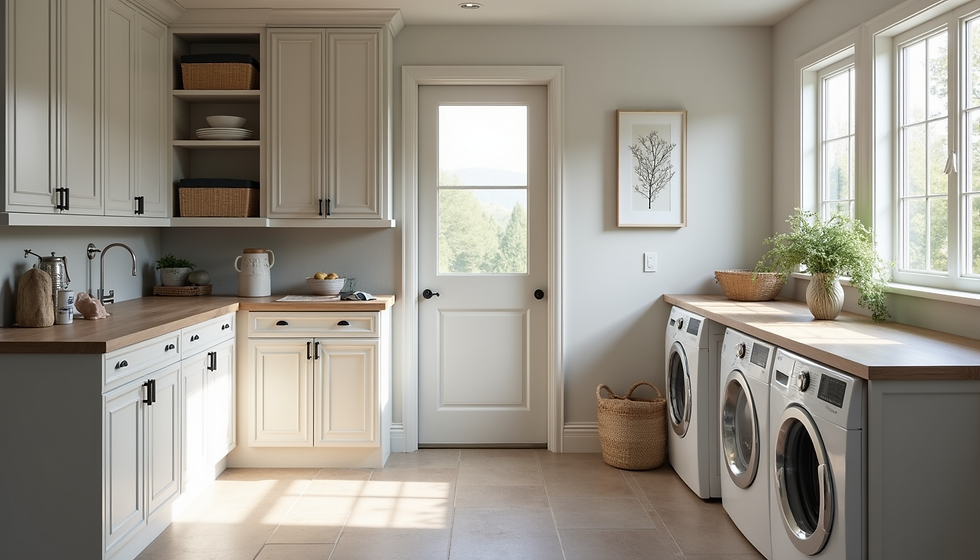Exploring the Impact of Different Types of Lighting on Home Design and Mood
- The Home Tuner
- Jun 4
- 4 min read
Updated: Jul 25
Lighting plays a vital role in our daily lives. It shapes how we perceive our surroundings, influences how we feel, and sets the stage for daily activities. Whether you’re cooking, reading, or relaxing, the right lighting can make all the difference. In this post, we’ll explore the three key types of lighting—ambient, task, and accent—and discuss how to incorporate them effectively in your home. With the growth of smart lighting technology, there are even more opportunities to enhance your living spaces. Let’s dive in!
Understanding the Types of Lighting
Lighting can be categorized into three primary types: ambient, task, and accent. Each type serves a specific function and contributes uniquely to the overall design of your home.
Ambient Lighting
Ambient lighting is the overall illumination that fills a room, providing a comfortable level of brightness for everyday activities. Think of it as the base layer of lighting. This can come from ceiling fixtures, recessed lighting, or oversized floor lamps.
Creating an inviting atmosphere depends on evenly distributing ambient lighting. If there are too many shadows or dark corners, the space may feel unwelcoming. For optimal results, consider adding dimmers. About 60 percent of homeowners find that using dimmers effectively adjusts the mood, allowing for brighter spaces during the day and softer lights in the evening, making it perfect for winding down.
Task Lighting
Task lighting is specifically aimed at providing focused light for activities that require attention and clarity. This includes reading, cooking, or working on hobbies. Task lighting should be brighter than ambient lighting and strategically placed where you need it most.
For instance, if you love reading, a well-placed floor lamp next to your favorite chair can make a world of difference. In kitchens, under-cabinet lighting illuminates countertops, helping prevent accidents while cooking. Studies show that 75% of people feel they are more productive when their task areas are well-lit. Using adjustable options, like a lamp with a moveable arm, ensures that your lighting can adapt to different tasks, enhancing both effectiveness and enjoyment.
Accent Lighting
Accent lighting adds drama by highlighting specific features or decor items in your home, such as artwork or architectural details. This type of lighting usually has a stronger output compared to ambient lighting, creating focal points within your space.
Common examples of accent lighting include spotlights that shine on a sculpture or wall sconces that frame a doorway. Properly executed, accent lighting can make a small room feel larger and more dynamic by creating contrasts and visual interest. A well-lit picture can enhance its beauty and draw the eye in a way that a dimly lit piece cannot.
The Rise of Smart Lighting
Thanks to technology, smart lighting has become increasingly popular. With smart lighting systems, homeowners gain unprecedented control over brightness, color, and timing through mobile apps or even voice commands.
Benefits of Smart Lighting
Investing in smart home lighting can offer substantial benefits:
Customization: Homeowners can set lighting for various activities. For example, a vibrant white light can energize a morning routine, while soft, warm tones can create a calming atmosphere for relaxation.
Energy Efficiency: Many smart lighting options use LED technology, which can consume up to 90% less energy than traditional incandescent bulbs. This not only reduces electricity bills but also has a positive impact on the environment.
Convenience: The ability to control lighting remotely means minor adjustments can be made from any room in the house, allowing for great flexibility and comfort.
Impact on Mood and Function
The type of lighting in a room can greatly affect its mood. A study showed that 68% of participants felt more relaxed in spaces with warmer lighting. In contrast, brighter, cooler lighting is invigorating and promotes alertness, making it ideal for work or study areas.
Combining ambient, task, and accent lighting with the features of smart lighting can completely transform a home. For instance, setting a ‘Movie Night’ scene that dims ambient lights while turning on accent lights can create a cozy viewing experience with just one command.
Combining Lighting Techniques for Home Design
To maximize the impact of lighting in your home, thoughtful planning is essential. Here are some practical tips for effectively merging ambient, task, and accent lighting:
Assess Your Activities: Identify the primary activities in each room. This will help you determine the lighting levels and types you'll need. For example, a home office will require more focused lighting for work tasks.
Use Layers: Layering different types of lighting provides versatility. Ambient lighting can create a warm glow, task lighting focuses on functionality, and accent lighting adds character, harmonizing the overall feel of the room.
Choose Dimmable Options: Dimmable lights allow you to smoothly transition from bright settings to softer tones, greatly enhancing the mood of a space.
Be Mindful of Fixture Placement: Proper placement of lighting fixtures ensures optimal illumination and minimizes glare. For instance, overhead lights above work areas can enhance visibility and performance.
Integrate with Design Aesthetics: Select lighting fixtures that complement your home’s style. Whether you favor modern designs or classical styles, the right lighting should enhance your home’s overall aesthetic.
Balancing these various elements of lighting can significantly enhance both the functionality and ambiance of your home, ensuring each room meets both practical needs and visual appeal.

Final Thoughts
The influence of lighting on home design is undeniable. By understanding how ambient, task, and accent lighting work together, alongside the potential of smart lighting, you can create spaces that are both functional and inviting. Strategic application of these principles not only improves the aesthetics of your home but also enhances your emotional well-being.
As interior lighting design continues to evolve, staying informed and trying different techniques will help ensure your home remains a comfortable and charming retreat. Embrace the light, and watch your living spaces come alive!




Comments